2018
Twenty Years of Digital Media: What's Hot in CG?
November 10
The Digital Media Design Program is celebrating its 20th Anniversary. Please join us as we celebrate this unique interdisciplinary program with a panel of alumni experts to talk about the state of the art in Animation, Games, Social Media and Virtual Reality. If you've ever wondered what it would be like to work at a major animation, VR, or game studio, or were curious about the technological advances being made in these fields, please join us for a fun and informative morning.
Panelists include:
Lu Chen, InstagramRay Forziati, Netflix
Marley Gilb, BlueSky Animation Studios
Paul Kanyuk, Pixar Animation
Mike Lang, Etsy
Tamara Levy, Kongregate
Jason Merrin, Hyperbolic Media
Emre Tanirgan, Magic Leap
Nancy Tsang, Pixar Animation
2013
Jesse James Allen presents "EA Audio -- An Inside Look"
March 20
Have you ever wondered how EA makes the crowds cheer in Madden Football or engines roar in Need for Speed? Jesse James Allen, sound designer on 44 games from Electronic Arts presents an in-depth look at the interactive audio designs and methodologies that have been used to create some of EA.s biggest hits over the past ten years.
Sophie Joerg presents "Perceiving and Animating Finger Motions"
March 14
Creating compelling finger motions for realistic virtual characters is a challenging and time-consuming process. Motion capturing the body movements of actors to create animations for movies, games, and VR applications has become standard practice, but finger motions are usually added manually. In this talk, I will show how important correct finger motions are as determined by our perceptual experiments. Then, I will present a method to automatically create plausible fingers motions for gesturing and conversing characters. Our algorithm locates suitable finger motion segments from a database based on the similarity of the arm motions and the smoothness of consecutive finger motions. Our approach provides good results for a number of examples with different gesture types.
Bio:
Sophie Joerg is an assistant professor in the Visual Computing division of the School of Computer Science at Clemson University. Her research interests are in computer graphics, specifically character animation and perception. Before joining Clemson, she received her PhD from Trinity College Dublin, Ireland, and was a postdoctoral researcher at Carnegie Mellon University.
Pixar Tech Talk and Info Session
February 24-25
Matt Kuruc (Technical Director,DMD Alum), Paul Kanyuki (Technical Director,DMD Alum), and Peggy Dollaghan (HR) talk about some of their latest film work as well as employment opportunities at Pixar Studios.
Blue Sky Tech Talk and Info Session
February 11
Roberto Calvo (Head of Production Engineering) and Debra Blanchard (Head of Recruiting) talk about production engineering and employment at Blue Sky Studios.
Lightwall Code Party and Competition
February 1
On February 1st at 4pm, the SIG Center for Computer Graphics will be hosting a hackathon for programming the Moore building lightwall. Prizes will be given to the best submissions. All accepted submissions will be shown on the wall throughout the semester.
2012
Dreamworks Tech Talk and Info Session
December 4
Ray Forziati (Supervising Technical Director and DMD alum) and Marilyn Friedman (Director of Recruiting) will give a tech talk and info session. Ray will discuss his recent work for the film "Rise of Guardians". Marilyn will talk about what it takes to be a technical director at DreamWorks. Ray and Marilyn are pros of the industry, and this talk is crucial for anyone looking to enter the animation field.
Special Talk by Justine Cassell, Director of the Human-Computer Interaction Institute, Carnegie Mellon University
November 19
Justine Cassell will present "Building Rapport between People and Machines: Why and How", Monday, November 19, 2012, as a Grace Hopper Lecture Series is a Fall event.
In thinking about the interaction between computers and people we often concentrate on the task or cognitive aspects of the collaboration. However,the social aspects of interaction that characterize human-human collaboration also come into play in human-computer collaboration, and understanding the nature of that social interaction can help us to design computational systems that are most effective in real world contexts. To that end, in this talk I report on a series of studies that look at the building of rapport between humans, and between humans and virtual humans. I look at the effects of this rapport building on tasks as concrete as giving directions and educational tutoring. From the results of these studies I draw conclusions about the need for studies of actual human-human interaction to inform the design of robots and graphical agents and, more generally, the need to have models of the interaction between humans and computers to draw on not just technical but also social and cultural phenomena.
Justine Cassell is the Charles M. Geschke Director of the Human Computer
Interaction Institute in the School of Computer Science at CMU. Before coming to CMU, Cassell was faculty at Northwestern University from 2003 to 2010 where she was the founding director of the Center for Technology and Social Behavior. Before that she was a tenured professor at the MIT Media Lab. Cassell received the Edgerton Prize at MIT, is an ACM and CRA Distinguished Lecturer, was honored in 2008 with the "Women of Vision" award from the Anita Borg Institute, and in 2011 was named to the World Economic Forum Global Agenda Council on Robotics and Smart Devices. She spoke at the World Economic Forum in Davos in January 2012 on the promises and perils of online learning.
Special Talk by Graham Sellers, AMD OpenGL driver team lead
November 19
Graham Sellers presents "OpenGL: The Implementer.s Perspective"
In this talk, we will approach the subject of computer graphics and OpenGL in particular from the implementer and hardware vendor.s point of view. We will discuss modern graphics hardware architectures, and the architecture of graphics drivers. We.ll take a look at how performance is achieved in graphics hardware through parallelism, and explore recent features of OpenGL and how they can be used to take advantage of the computing power of the GPU. Some techniques for maintaining throughput in a graphics application will be discussed. We.ll also describe the process at Khronos, the standards body responsible for OpenGL, OpenGL-ES, OpenCL and a number of other key technologies, how extensions come to be and how they make it into the OpenGL specification.
Graham is a Senior Manager at AMD and leads AMD.s OpenGL driver team. He is responsible for the production of OpenGL drivers for AMD.s Radeon HD and FirePro graphics processors. His team.s duties include performance tuning, porting the drivers to new GPU architectures, and the implementation of new features such as extensions and new versions of OpenGL. Graham is also the author of the OpenGL SuperBible, the OpenGL Programming Guide, many OpenGL extensions, and the core OpenGL specification. Full details
Special Talk by Dave Shreiner, ARM Inc.
November 12
Dave Shreiner presents "Mobile Graphics, OpenGL, and the Future of Graphics Programming"
Computer graphics as a discipline has been around for a long time, but with the rise of mobile platforms capable of workstation-level graphics, the comfortable world of programming graphics is rapidly changing once again. This talk covers a lot of territory in this rapidly changing landscape: from discussions of the design and implementation of mobile graphics platforms, the most prolific systems being deployed today; to how to program those devices to maximize the new performance metrics: power, battery life, and energy dissipation; and perspectives on how graphics programming (particularly emphasizing OpenGL) has evolved, and will be different in the future in light of these changes.
Dave Shreiner (BS, Mathematics) is an engineer, author, educator, and API politician who has worked in the OpenGL community almost since its inception over 20 years ago. He.s contributed to its evolution through code and specifications, documented its adoption in courses and books, and helped design numerous systems that relied on OpenGL as a major graphics component. Full details
Special Talk by Norman I. Badler, University of Pennsylvania
September 13
Normal I Badler presents "Eliminating the visual boundary between real and virtual" at 5:30 p.m., room 402 in Claudia Cohen Hall (Penn Visual Studies).
Dr. Badler is the Director of the Center for Human Modeling and Simulation, Professor in Computer and Information Science, and Director and Faculty Advisor of the Digital Media Design Program.
Pixar Tech Talk and Recruitment Program
September 24 and 25
Paul Kanyuk, Matt Kuruc, and Nina Padulla will give a technical talk, followed by information on internships and employment at Pixar.
Special Talk by Norman I. Badler, University of Pennsylvania
September 22
Normal I Badler presents "Digital Animation From a Technical Perspective" at Enchanted Drawing II: Animation Across the Disciplines
Dr. Badler is the Director of the Center for Human Modeling and Simulation, Professor in Computer and Information Science, and Director and Faculty Advisor of the Digital Media Design Program.
EA Tech Talk and Recruitment Program
September 12
Andre Thomas (Head of Graphics at EA Florida) and Chris Davis (HR at EA) will give a technical talk, followed by information on internships and employment at EA.
Resume workshop by Yoni Lanteiner of Zynga
September 12
Yoni Lanteiner (University Relations Manager at Zynga) will give a resume workshop.
Szymon Rusinkiewicz, Princeton University
March 22
Szymon Rusinkiewicz discusses "Physical Reproduction of Materials with Specified Reflectance and Scattering"
Szymon Rusinkiewicz is an associate professor of Computer Science at Princeton University. His work focuses on digital representations of the 3D shape and appearance of real-world objects, including the design of acquisition and fabrication devices, data structures for efficient manipulation, and applications (most notably to cultural heritage objects and human skin). He investigates algorithms for processing complex datasets of geometry and reflectance, including registration, matching, completion, hierarchical decomposition, symmetry analysis, and sampling. His research interests also include illustrative depiction through line drawings and non-photorealistic shading models.
Blue Sky Tech Talk and Recruitment Program
March 15
Michael Reed gave a technical talk, followed by Debra Blanchard, Director of Studio Recruiting.
Michael Reed is a Senior Research Associate at Blue Sky Animation Studios, where he will continue his work with geometric surface construction techniques to create new solutions in rendering and geometry for Blue Sky. Michael is also an Adjunct Associate Professor in Columbia's computer science department, where he teaches Computer Graphics and Computational Aspects of Geometric Design. He received his M.S. and Ph.D. in Computer Science from Columbia University, his B.S. in Physics from the State University of New York at Albany, and has held appointments at the research laboratories of IBM, Philips, and Bell Atlantic corporations. His research interests can be broadly categorized as "geometry + computing" and include the study of techniques for the sensing, modeling, and generation of physical objects and phenomena.
2012 GRASP/HMS Seminar - Aaron Hertzmann
February 3
"Feature-Based Locomotion Controllers for Physically-Simulated Characters"
Abstract:
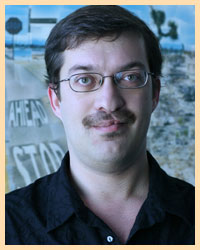
Understanding the control forces that drive humans and animals is
fundamental to describing their movement. Although physics-based
methods hold promise for creating animation, they have long been
considered too difficult to design and control. Likewise, recent
results in computer vision suggest how physical models, if
developed, could be important to human pose tracking.
I will describe the main problems of human motion modeling.
I will then present a new approach to control of physics-based
characters based on high-level features of human movement.
These controllers provide unprecedented flexibility and
generality in real-time character control: they are capture
many natural properties of human movement; they can be easily
modified and applied to new characters; and they can handle a
variety of different terrains and tasks, all within a single
control strategy.
Until very recently, even making a controller walk without
falling down was extraordinarily difficult. This is no longer
the case. Our work, together with other recent results in this
area, suggests that we are now ready to make great strides in
locomotion.
2012 Computer Graphics Colloquium - Hao Li
January 19
Computer Graphics Colloquium speaker, Hao Li who is a post-doctoral researcher working with Professor Eitan Grinspun(Columbia) and Professor Szymon Rusinkiewicz(Princeton) gave a talk on tracking deformable surfaces.
2011
2011 Fall Distinguished Lecture Series - Ladislav Kavan
December 6
"3D Virtual Characters: Skinning, Clothing, and Weird Math"
Abstract:
In this talk I will present my research on real-time 3D graphics and virtual characters. In the first part, I will introduce myself and several projects I've been working on. In the second part, I will talk in detail about skinning---a popular method to animate virtual characters in real-time. I will explain how dual quaternions can be used to obtain better quality skinning than the standard technique based on matrices. I will follow with our approach to real-time cloth animation, discussing how to create an upsampling operator that adds fine-scale details to coarse mesh simulations. The main tricks needed to make upsampling work robustly include harmonic regularization (an extension of the classical Tikhonov approach) and our take on "tracking," i.e., constraining fine-scale physics to follow a given coarse-scale animation. Finally, I will conclude with some ideas for future work, for example, how to make digital content creation more intuitive.
2011 Fall Distinguished Lecture Series - Eitan Grinspun
November 22
"From Sorcery to Science: how Hollywood Physics Impacts the Sciences"
Abstract:
Cinema uses computers to animate physics. Special effects such as explosions and lifelike depictions of imaginary characters are made possible by mathematical and computational models that capture qualitative, characteristic behavior of a mechanical system. This is scientific computing with a twist. I will describe the process by which we derive and compute models of physics, and show actual examples of resulting technologies in film, consumer products, physics, and medicine. Our research group develops scientific computing tools by focusing on the underlying geometry of the mechanical system. I will describe a process in which we build a discrete picture from the ground up, mimicking the axioms, structures, and symmetries of the smooth setting. I will survey the problems we address using this methodology, such as computing the motion of flexible surfaces, cloth, hair, honey, and solids experiencing mechanical contact. Industry and academia has adopted these methods to improve products such as Adobe Photoshop, films such as Disney's Tangled, train surgeons, and understand nonlinear soft-matter phenomena.
Sony Imageworks Recruiting Talk and Interviews
November 21-22
Microsoft Games Recruiting Talk and Interviews
November 14-15
DMD Senior Project Alpha Reviews
October 28
Demo Reel Night
October 12
Pixar Tech Talk and Interviews
September 26-27
Lucas Arts Tech Talk
September 22
Zynga Information Session
September 20
PennApps Hackathon
September 16-18
Summer Research Poster Presentations
September 16
Students who did research at Penn, including those who worked in the SIG lab, presented the results of their work in Levine Hall. Among the visitors were four faculty members who acted as judges and gave awards to the posters they deemed to be the top three. Third place went to Casey Davis, second place went to Yonas Solomon, and first place went to Kaitlin Pollock.
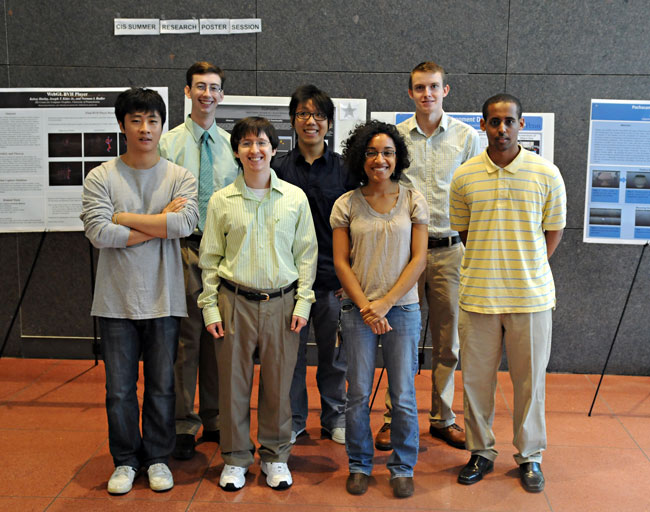 |
Pictured from left to right:
Shutong Yu, Adam Mally, Matt Jones, Tiantian Liu, Marley Gilb, Casey Davis, and Yonas Solomon.
Microsoft recruitment talk
September 14
2011 Fall Distinguished Lecture Series - Nancy Pollard
September 13
"Directing Physically Based (and Physical) Interactions: New Interfaces for Animation Control"
Abstract:
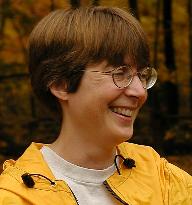
Our ongoing research in pedestrian simulation has resulted in two
major approaches. The first approach is to use egocentric affordance
fields to simulate autonomous pedestrians in dynamically changing, large, complex worlds. The second technique uses a novel, hybrid,
rule-based framework which combines reactive state machines,
predictive collision avoidance and space time planning for robust
steering. We have also developed a method for externalizing steering
logic.
As an added bonus, this idea of direct control of a running simulation transfers directly to control of robots, and I will present a system for teleoperating a multifingered robot hand using multitouch and other sensing capabilities of, for example, the iPad for direct user control of simple assembly, sliding, rotation, and cloth manipulation.
Our ultimate goal is to understand the factors that contribute to natural and compelling motion, and in that context, I will also briefly consider other questions in and beyond computer animation, such as what does it mean for two individuals or species to move in a similar fashion? .. and how do we begin to categorize the vast range of manipulation actions that people can be observed to perform on a daily basis?
Twilio information session
September 13
Guest Lecture - Benedict Brown
July 18

Benedict Brown, a post-doctoral fellow at the Katholieke Universiteit Leuven, gave a lecture on reconstructing ancient frescoes with the aid of computers.
Computer Graphics Colloquium Speaker: Mubbasir Kapadia
May 12
"Pedestrian Simulation"
Abstract:
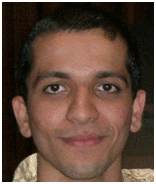
Our ongoing research in pedestrian simulation has resulted in two major approaches. The first approach is to use egocentric affordance fields to simulate autonomous pedestrians in dynamically changing, large, complex worlds. The second technique uses a novel, hybrid, rule-based framework which combines reactive state machines, predictive collision avoidance and space time planning for robust steering. We have also developed a method for externalizing steering logic.
Computer Graphics Colloquium Speaker: Jassim Happa
April 29
" High-Fidelity Rendering and Display of Cultural Heritage"
Abstract:
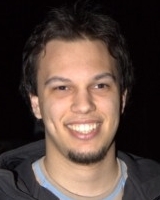
Cultural heritage represent a large portion of our collective legacy
and must be recognized for having contributed to the shaping of
society today. Study of them can prove valuable to all sub-fields of
the arts and sciences. Unfortunately, a considerable amount of
knowledge about the past is lost today. This may subtract from what
might be learned about traditions, lifestyles and events in history.
The correct documentation, rendition and interpretation of extant
monuments are therefore vital in order for us to better understand the
past and preserve it for future generations.
High-fidelity rendering of cultural heritage has been a research
interest in the computer graphics and history and archaeology domains
for the past two decades. This presentation details the state of the
art in photorealistic rendering of cultural heritage, the challenges
specific to recreating the past, and overviews the work done by the
visualization group in the International Digital Laboratory at
Warwick. First, three reconstruction case studies with an unbiased
rendering pipeline are described: A Byzantine church on Cyprus, a
Coptic monastery in Egypt and the head of a Roman Statue. Second, a
research framework to reverse-engineer the past is presented. The
framework is an extension of the well-established Predictive Rendering
pipeline by introducing a historical comparison step allowing for
historical experts to provide valuable input in the effort to deliver
plausible renditions of the past. Third, a novel method to render
naturally lit real world environments in virtual space using
empirically captured Image-based Lighting is presented. The method is
useful for relighting difficult, dark interior scenes, making it
especially useful for cultural heritage rendering purposes. Finally,
the uses of High Dynamic Range Imaging and Video as means to document
cultural heritage is described.
Computer Graphics @ Penn Day
April 28
The DMD seniors presented their capstone projects to professors, visitors, and other students in the SIG lab. The event continued in Levine Hall where students from the Physically-Based Animation, Advanced Topics in Computer Graphics and Animation, GPU Programming and Architecture, and the Senior Capstone Project classes presented their project posters.
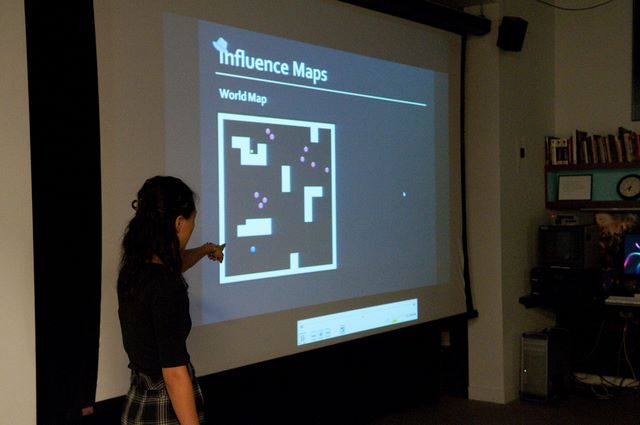 |
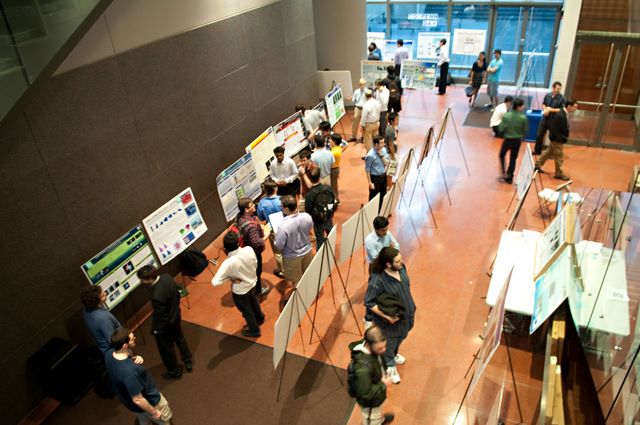 |
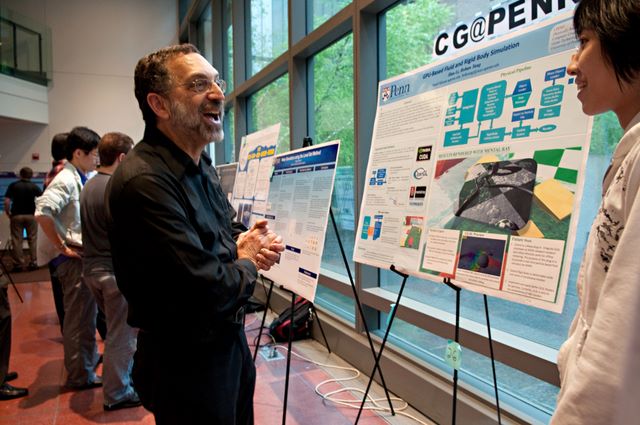 |
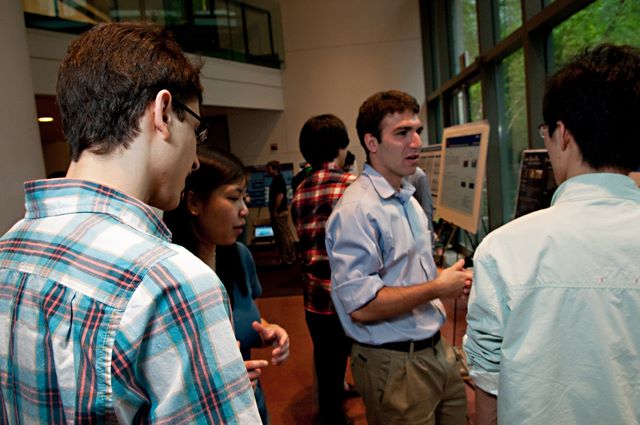 |
CIS Colloquium Speaker: Petros Faloustos
April 14
"Animating Virtual Humans"
Abstract:
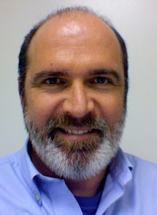
Virtual humans are a crucial element of many interactive applications, such computer games, urban and
critical situation simulation, medicine et al. To simulate a virtual human with high fidelity, we need to address many elements of what is often modeled as a layered system: from the low level motor control, to the higher level coordinated behaviors, expressive facial animation, and, at the highest level, cognition.
In this talk, I will present an overview of my work on human modeling and simulation, covering all but the highest levels of virtual human modeling. In particular, I will describe a few of our projects related to motion editing and motor control, practical applications of physics-based animation, facial animation, and
sketch-based interfaces. I will also show how physics-based models can improve planning and steering for virtual humans, and touch on projects related to behavior authoring and coordinated planning. For selected projects, I will go into more depth and present in detail the techniques and methods used. Time permitting
I will also describe our work on designing hardware and software accelerators for the physics-based simulation component of interactive applications that involve virtual humans, such as computer games.
I will conclude the talk with a discussion of projects in areas other than virtual human simulation, and future research plans.
CIS Colloquium Speaker: Taku Komura
March 31
"Spatial Relationship-Based Representation for Humanoid Control"
Abstract:
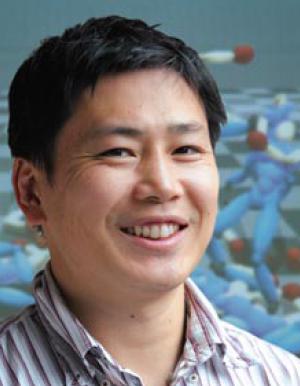 Close interactions, not necessarily with any contacts, between different body parts of single or multiple humanoids, or with the environment, are common in computer animation and robotics. Characters dancing Rambada, wrestling with each other, or robots moving through a constrained environment are some examples. Existing scene descriptors have a fundamental limitation in handling such close interactions. Currently, a motion is typically described in terms of joint angles and kinematic constraints, such as contacts. With this representation, automatically computing a valid motion requires randomized exploration and significant computational costs for collision detection.
Close interactions, not necessarily with any contacts, between different body parts of single or multiple humanoids, or with the environment, are common in computer animation and robotics. Characters dancing Rambada, wrestling with each other, or robots moving through a constrained environment are some examples. Existing scene descriptors have a fundamental limitation in handling such close interactions. Currently, a motion is typically described in terms of joint angles and kinematic constraints, such as contacts. With this representation, automatically computing a valid motion requires randomized exploration and significant computational costs for collision detection.
In order to cope with this problem, my research group has been exploring a new representation that is based on the spatial relationships between body parts, objects and the environment. In this talk, I will introduce two different approaches. The first representation called Topology Coordinates describes how much body parts are twisted around each other. The second representation called Interaction Mesh describes which body parts are in close proximity with one another.
These representations have a wide range of applications. In computer animation, we can easily edit or retarget human movements while preserving the context of the scene. Also, the similarity between two different scenes can be computed based on a distance metric defined upon these representations, which will be useful for motion interpolation, indexing and retrieval. In robotics, they can be used for imitation learning, in which robots with different morphology and degrees of freedom need to mimick the movements of the human. I will present the experimental results and also present the future direction of our work.
CIS Colloquium Speakers: Jeff Hora and Jamie King
March 29
Jeff Horing
Managing Director at Insight Venture Partners.
Area of focus includes mobile online gaming.
Jamie King
Founder and Chief Creative Officer of 4 mm Games.
Produced award - winning games such as Max Payne,
Red Dead Revolver, and the Grand Theft Auto franchise.
Blue Sky Studios Tech Talk and Employment Overview
March 22
Speakers:
Dylan Maxwell, Materials Technical Director
Debra Blanchard, Director of Studio Recruiting
Pixar Animation Studios Tech Talk and Employment Overview
February 24
Digital Media Design alumni Paul Kanyuk and Ariela Nurko described working in crowd simulation and rendering at Pixar. They also described the pipeline process of making an animated film. Tricia Green, University Relations, went over what Pixar looks for in an applicant and answered students' questions about applying for jobs and internships.
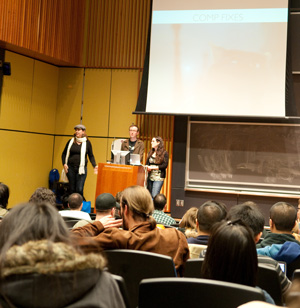 |
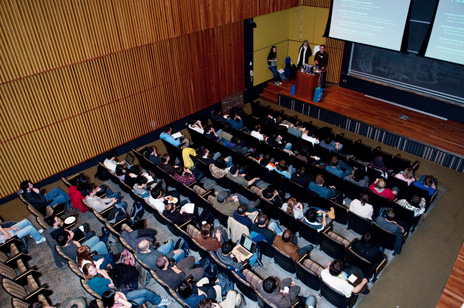 |
Sony ImageWorks Tech Talk
February 23
Ken Maruyama, Director of Digital Production at Sony Imageworks, outlined what Sony wants in an intern.
"Data-Driven Physically-Based Animation"
February 22
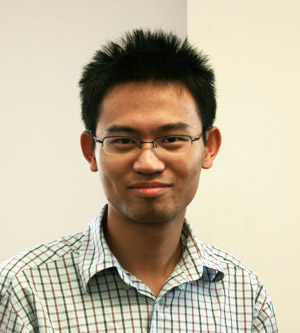 Huamin Wang of the Department of Electronic Engineering at the University of California gave a guest lecture on physically-based animation.
Huamin Wang of the Department of Electronic Engineering at the University of California gave a guest lecture on physically-based animation.
Abstract:
Although physically based animation is widely used to produce
high-quality visual effects for movies and games nowadays, its
computational and memory cost is still notoriously high, especially
for real-time graphics and visualization applications. How can we make
animations more realistic and more efficient at the same time? I
believe the answer is to use real-world data. This talk introduces a
data-driven framework that transfers details from real-world data into
synthesized animations, so that they can be generated with both
fidelity and efficiency. Animation examples that can benefit from this
framework will be discussed in details with their potential
applications in movie production, game development and scientific
visualization.